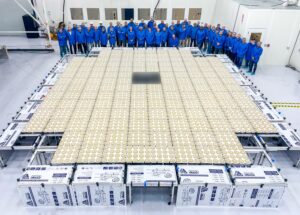OneWeb and Arianespace signed an agreement following the suspension of the launches
Wednesday, 14 September 2022 23:23 Following the suspension of OneWeb's launches in March 2022, OneWeb and Arianespace have reached an agreement pursuant to which performance of the Launch Services Agreement may be resumed in the future. The terms of the settlement are confidential.
Arianespace is supporting OneWeb on its upcoming launches; including the performance of Dispenser Supply Services for two launches to be perfor
Following the suspension of OneWeb's launches in March 2022, OneWeb and Arianespace have reached an agreement pursuant to which performance of the Launch Services Agreement may be resumed in the future. The terms of the settlement are confidential.
Arianespace is supporting OneWeb on its upcoming launches; including the performance of Dispenser Supply Services for two launches to be perfor KTSAT contracts with Satconsult to provide expert oversight of satellite construction
Wednesday, 14 September 2022 23:23 Euroconsult has announced that its affiliate, Southern Aerospace and Telecom Consulting (Satconsult) has contracted with KTSAT to provide expert oversight throughout the build of Koreasat 6A satellite. The contract marks the third time that KTSAT will put its trust in Satconsult's depth of expertise to support the monitoring and control of the manufacturing process and advise on best practices f
Euroconsult has announced that its affiliate, Southern Aerospace and Telecom Consulting (Satconsult) has contracted with KTSAT to provide expert oversight throughout the build of Koreasat 6A satellite. The contract marks the third time that KTSAT will put its trust in Satconsult's depth of expertise to support the monitoring and control of the manufacturing process and advise on best practices f China launches Zhongxing-1E satellite
Wednesday, 14 September 2022 23:23 China successfully sent a new satellite into space from the Wenchang Spacecraft Launch Site in the southern island province of Hainan on Tuesday.
The satellite, Zhongxing-1E, was launched at 9:18 p.m. (Beijing Time) by a modified version of the Long March-7 carrier rocket and entered the planned orbit successfully. It will provide high-quality voice, data, radio and television transmission
China successfully sent a new satellite into space from the Wenchang Spacecraft Launch Site in the southern island province of Hainan on Tuesday.
The satellite, Zhongxing-1E, was launched at 9:18 p.m. (Beijing Time) by a modified version of the Long March-7 carrier rocket and entered the planned orbit successfully. It will provide high-quality voice, data, radio and television transmission Beyond Gravity lays foundation for next growth phase
Wednesday, 14 September 2022 23:23 Beyond Gravity ignites the next stage on its way to privatization: In addition to Launchers and Satellites, Lithography is established as a third division. The business with apertures and stabilizers for the production of microchips has grown strongly in recent years and is showing promising development. Furthermore, the support functions in the company will be reorganized into Finance, HR and C
Beyond Gravity ignites the next stage on its way to privatization: In addition to Launchers and Satellites, Lithography is established as a third division. The business with apertures and stabilizers for the production of microchips has grown strongly in recent years and is showing promising development. Furthermore, the support functions in the company will be reorganized into Finance, HR and C NASA funds projects to study orbital debris, space sustainability
Wednesday, 14 September 2022 23:23 As part of NASA's efforts to address orbital debris, the agency is funding research proposals from three university-based teams over the next year to analyze the economic, social, and policy issues associated with space sustainability.
Orbital debris consists of human-made objects orbiting Earth that no longer serve a purpose, including mission-related and fragmentation debris, nonfunction
As part of NASA's efforts to address orbital debris, the agency is funding research proposals from three university-based teams over the next year to analyze the economic, social, and policy issues associated with space sustainability.
Orbital debris consists of human-made objects orbiting Earth that no longer serve a purpose, including mission-related and fragmentation debris, nonfunction Taikonauts enjoy 'home-grown' meal during Mid-Autumn Festival
Wednesday, 14 September 2022 23:23 During this year's Mid-Autumn Festival, three Chinese astronauts onboard the country's space station has, for the first time, eaten fresh lettuce they planted themselves in space, along with mooncakes and other delicious food.
The three astronauts entered the Tiangong space station in June. They brought seeds, including those of lettuce, and cultivated them in the space station.
Afte
During this year's Mid-Autumn Festival, three Chinese astronauts onboard the country's space station has, for the first time, eaten fresh lettuce they planted themselves in space, along with mooncakes and other delicious food.
The three astronauts entered the Tiangong space station in June. They brought seeds, including those of lettuce, and cultivated them in the space station.
Afte Proposed Tandem4EO constellation will combine radar and optical imaging for Europe
Wednesday, 14 September 2022 23:23 ICEYE, the owner of the world's largest synthetic-aperture radar (SAR) satellite constellation and SATLANTIS, a leading New Space optical imaging company, has announced preliminary plans to develop and manufacture a proposed Tandem for Earth Observation (Tandem4EO) constellation consisting of two radar and two VHR optical satellites. The announced program is planned to support the New Space stra
ICEYE, the owner of the world's largest synthetic-aperture radar (SAR) satellite constellation and SATLANTIS, a leading New Space optical imaging company, has announced preliminary plans to develop and manufacture a proposed Tandem for Earth Observation (Tandem4EO) constellation consisting of two radar and two VHR optical satellites. The announced program is planned to support the New Space stra Space Development Agency’s first launch slips due to supply chain setbacks
Wednesday, 14 September 2022 17:49
The first launch of the Space Development Agency’s low Earth orbit satellites that had been scheduled for late September is slipping to no earlier than mid-December.
The post Space Development Agency’s first launch slips due to supply chain setbacks appeared first on SpaceNews.
DART spacecraft prepares to collide with asteroid target later this month
Wednesday, 14 September 2022 17:32
As NASA prepares to usher in a new form of planetary defense, one Johns Hopkins engineer will be eagerly awaiting the big collision that she is helping orchestrate.
Elena Adams, the mission systems engineer at the Johns Hopkins Applied Physics Laboratory, and her team will spend the next two weeks carefully observing Didymos, a double-asteroid system that poses no threat to Earth and yet will be the target of NASA's Double Asteroid Redirection Test—a first-of-its-kind, proof-of-concept mission that will intentionally crash a spacecraft into an asteroid's moonlet to deflect it away from its course.
"During the day of impact, I'll be more of a conductor, making sure that all of the orchestra is following the beat and playing their parts," said Adams, who will discuss the mission during talk in Hodson Hall on the university's Homewood campus on Thursday at 5 p.m.
Flying to (hypothetical) Planet 9: Why visit it, how could we get there and would it surprise us like Pluto?
Wednesday, 14 September 2022 15:08
In a recent study submitted to Earth and Planetary Astrophysics, an international team of researchers discuss the various mission design options for reaching a hypothetical Planet 9, also known as "Planet X," which state-of-the-art models currently estimate to possess a semi-major axis of approximately 400 astronomical units (AU). The researchers postulate that sending a spacecraft to Planet 9 could pose scientific benefits much like when NASA's New Horizons spacecraft visited Pluto in 2015. But does Planet 9 actually exist?
"It is hard to put a specific number on the confidence level because so many uncertainties remain," said Dr. Manavsi Lingam, who is an Assistant Professor at the Florida Institute of Technology, and a co-author on the study.
Microsoft continues expanding Azure Space
Wednesday, 14 September 2022 14:13
Microsoft is continuing to expand its role in the space sector on multiple fronts with a strategy built around partnerships.
The post Microsoft continues expanding Azure Space appeared first on SpaceNews.
Taking the dazzle out of CryoSat yields a first
Wednesday, 14 September 2022 14:00
Since it was launched more than 12 years ago, ESA’s CryoSat ice mission has dazzled by way of its sheer technological and scientific excellence. This superb Earth Explorer satellite has returned a wealth of information that has transformed our understanding of Earth’s ice and how it is responding to climate change. In some circumstances, however, being dazzled isn’t a good thing, particularly when it comes to measuring the height of sea ice from space during the summer.
A paper published in Nature describes how scientists have now found an ingenious way of removing
Bandwidth-hungry regional satellite operators hunting for options
Wednesday, 14 September 2022 13:17
Regional satellite operators are searching for faster ways to add more capacity to their networks to meet soaring demand for broadband, according to executives speaking at World Satellite Business Week here.
AST SpaceMobile secures communications with prototype
Wednesday, 14 September 2022 12:51
Direct-to-cell startup AST SpaceMobile is preparing to unfurl the largest commercial antenna ever deployed in low Earth orbit after establishing contact with its BlueWalker 3 prototype satellite.
The post AST SpaceMobile secures communications with prototype appeared first on SpaceNews.
Japan, Germany declare moratorium on anti-satellite missile tests
Wednesday, 14 September 2022 12:09
Japan and Germany pledged this week not to conduct direct-ascent anti-satellite (ASAT) missile testing, throwing their weight behind the U.S.-driven initiative launched in April to promote peaceful and safe use of outer space.

